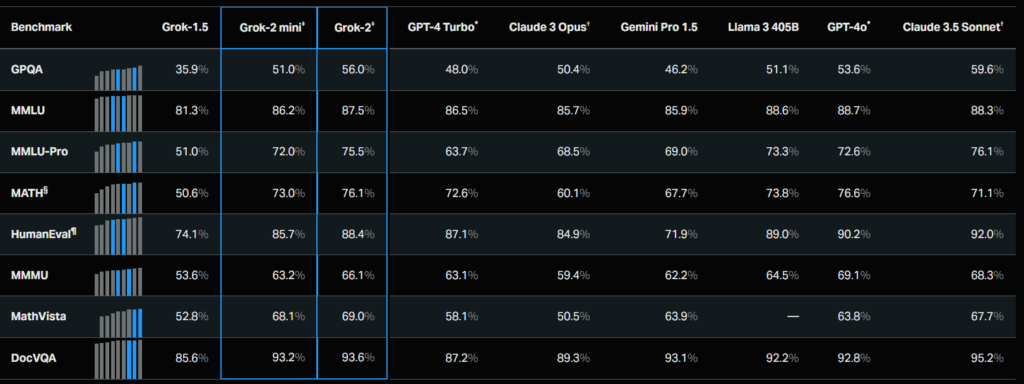The artificial intelligence landscape is evolving rapidly, with new models pushing the boundaries of what’s possible. In this post, we’ll dive deep into four of the most advanced AI models currently available: Grok-2, GPT-4o, Claude 3.5 Sonnet, and Gemini Pro. We’ll explore their capabilities, strengths, limitations, and potential applications.
Latest AI Benchmarks

To understand how these models stack up against each other, let’s look at their performance across various benchmarks:
1. GPQA (Graduate-Level Science Knowledge)
This benchmark tests advanced scientific understanding. Grok-2 shows impressive results here, demonstrating its capacity for complex scientific reasoning.
2. MMLU (Multidisciplinary Multiple-Choice Questions)
GPT-4o excels in this broad test of knowledge across multiple disciplines, showcasing its versatility.
3. MMLU-Pro
A more challenging version of MMLU, where Claude 3.5 Sonnet performs particularly well.
4. MATH
Grok-2 and GPT-4o demonstrate strong mathematical reasoning abilities in this benchmark.
5. HumanEval
Claude 3.5 Sonnet shines in this coding-focused test, indicating its strength in programming tasks.
6. MMMU
This test evaluates multilingual understanding, with GPT-4o showing robust performance.
7. MathVista
Grok-2 leads in this visual mathematical reasoning test, demonstrating its multimodal capabilities.
8. DocVQA (Document-based Question Answering)
Grok-2 performs exceptionally well here, showcasing its ability to extract and reason with information from documents.
Detailed Comparison
1. Grok-2
Structure and Functions:
- Developed by xAI
- Features powerful image generation capabilities based on the Flux model
- Can create realistic images from text prompts
Performance:
- Outperforms GPT-4 Turbo and Claude 3.5 Sonnet on the LMSYS leaderboard
- Excels in GPQA and MathVista benchmarks
Strengths:
- Image generation capabilities
- Strong performance in context understanding and reasoning
- Robust enterprise API with multi-region deployment
Limitations:
- Potential ethical concerns regarding image generation and copyright
2. GPT-4o
Structure and Functions:
- Latest in the GPT series
- Excels in text generation, comprehension, and coding
- Supports multimodal processing (text and image)
Performance:
- Outstanding results in MMLU and HumanEval benchmarks
Strengths:
- Versatility across various tasks
- Strong integration of text and image processing
Limitations:
- High resource requirements may limit real-time applications
3. Claude 3.5 Sonnet
Structure and Functions:
- Developed by Anthropic
- Focus on coding and problem-solving tasks
- Emphasis on ethical AI design
Performance:
- Consistently high scores in coding-related benchmarks like HumanEval
Strengths:
- Excels in coding and software development tasks
- Strong focus on ethical AI applications
Limitations:
- Limited multimodal capabilities compared to some competitors
4. Gemini Pro
Structure and Functions:
- Emphasis on conversational AI and natural language processing
- Optimized for real-time interaction
Performance:
- Strong results in chatbot arenas and NLP benchmarks
Strengths:
- Excels in conversational tasks and real-time interactions
- Ideal for customer service and virtual assistant applications
Limitations:
- May be less versatile in non-conversational tasks
Ethical and Legal Considerations
The image generation capabilities of models like Grok-2 raise important ethical and legal questions, particularly regarding copyright and potential misuse. It’s crucial for developers and users to implement strong content filtering mechanisms and clear guidelines for responsible use.
Conclusion
Each of these AI models brings unique strengths to the table:
- Grok-2 stands out for its image generation and scientific reasoning capabilities.
- GPT-4o offers versatility across a wide range of tasks.
- Claude 3.5 Sonnet excels in coding and ethical AI applications.
- Gemini Pro shines in conversational AI and real-time interactions.
As AI technology continues to advance, understanding the strengths and limitations of each model becomes crucial for businesses and researchers to leverage these tools effectively while addressing ethical concerns.
magnificent issues altogether, you just received a brand new reader. What could you recommend in regards to your put up that you simply made a few days ago? Any certain?
Your words have a certain serenity to them, like the feeling of being enveloped in a warm embrace.
Keep on working, great job!
my webpage nordvpn coupons inspiresensation; t.co,
Grok-2와 같은 이미지 생성 모델은 저작권과 잠재적 오용과 관련하여 어떤 윤리적·법적 문제를 제기할 수 있을까요?
이미지 생성 모델은 진실과 거짓이 없는 세상을 만들 것입니다.